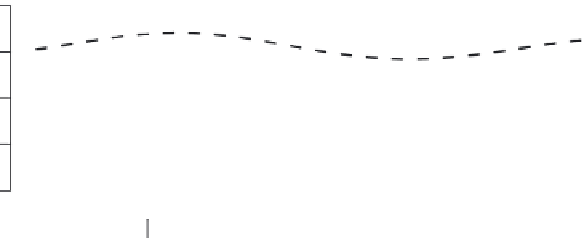Biology Reference
In-Depth Information
400
300
200
100
µ
0
µ
1
NNBA
0
2007
2008
2008
2008
IV
II
III
IV
Time (weeks)
Figure 12.6
Aberration detection for the 75-84 age group series using a time-varying negative binomial
CUSUM. Shown are the time-varying in-control and out-of-control means and the number
needed before an alarm (NNBA). Triangles indicate alarms.
model and use
predict
to obtain the expected value
μ
0
,t
during phase 2.
Figure 12.6 illustrates the
μ
0
,t
predictions based on this GLM model.
If, for example, one wanted to optimally detect a 20% increase in the mean,
one would have κ
= 1.2. Again, the choice of κ depends very much on the
specific application and mode of operation. Together with the threshold g,
the value of κ determines the distribution of the run-length as further inves-
tigated in Section 12.1. The resulting
μ
1
,t
is shown in Figure 12.6. Also shown
is the number needed before alarm (NNBA) at each time
s
. This number is
obtained by reversing Equation 12.5 with known threshold
g
, that is, given
r
s
−
1
find the minimum
y
s
such that
r
s
>
g
.
R> kappa < − 1.2
R> s.nb < − glrnb(momo[, "[75,85)"], control = list(range =
phase2, alpha = 1/m$theta,mu0 = mu0, c.ARL = 4.75, theta =
log(kappa), ret= "cases"))
The above code extracts the dispersion parameter α from the
glm.nb
fit;
note the slightly different parametrization of the dispersion parameter here.
For the threshold
g
(in
glrnb
denoted
c.ARL
), we use the value of 4.75. This
threshold value determines the distribution of the run-length
T
A
as investi-
gated in detail in Section 12.1; specifically, we show that
g ≈
4.75 results in
P(T
A
≤ 6 5|τ
= ∞) ≈ 0.1. The results from this call are illustrated in Figure 12.6.
For week 02 in 2008, an alarm is generated. Notice that the number of cases in
the previous week is not enough to sound an alarm itself, but helps to lower
the NNBA in the following week, where it is just about exceeded. No further
alarms are generated. The alarm is an example of excess mortality peaks in
the elderly that occur regularly during winter around the change of the year
and at the time of influenza epidemics.








